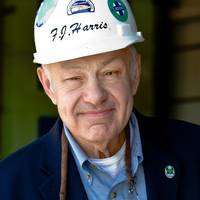Harris Joins J.F. Lehman Operating Executive Board

Frederick J. Harris, recently retired president of General Dynamics NASSCO and Bath Iron Works shipyards, has joined the operating executive board (OEB) of private equity firm J.F. Lehman & Company. The OEB is a group of industry and government executives with significant experience in the firm’s target industries. Through key relationships and sector-specific knowledge, OEB members contribute to sourcing and evaluating transactions, advising on portfolio company strategy and recruiting senior level portfolio company management.
World Renowned Propeller Expert To Retire
After a career leading the modernization of U.S. ship and submarine technology, Dr. William B. Morgan, Head of the Carderock Division's Hydromechanics Directorate, is retiring December 30th with almost fifty years of service. During his career, the Iowa native brought computers into naval engineering, revolutionizing propeller design by shifting from empirical to theoretical, becoming the first in the world to put the theoretical propeller data into a computer. This dramatically reduced propeller noise, enhancing submarine and ship acoustic characteristics. For example, he and his associates developed the highly skewed propeller with its superior vibration and acoustic properties. His largely unheralded work helped the United States win the Cold War. Dr.
People & Company News
Maritime Surveys Ltd., Shoreham, Sussex, U.K., recently took delivery of the first SeaBat 8160 multibeam echosounder system from RESON A/S. The SeaBat 8160 was installed on one of Maritime's survey vessels, the Scotian Shore. Alastair MacDonald, managing director of Maritime Surveys, commented on the success of the sea trials: "The SeaBat 8160 delivered the highest quality multibeam survey data in a swath width of 1,300 meters at 3,000 meters water depth, even when experiencing a near 20 degree roll and 12 degree pitch. The excellent data quality combined with the system's portability makes the 8160 extremely valuable for our operations." During these trials the system was supported by GSE Rentals of Aberdeen who supplied a TSS POS M/V 320 system.
What Hull Shape Is Best?
Back at the dawn of maritime history, a coastal dweller first took a log and ventured out on the water. Over time his craft evolved from a rough log to one that had shape at the ends and was hollowed out. These changes to the basic log shape were the first example of modifying a hull form to increase carrying capacity, improve ride comfort, and to reduce resistance. Since then, shipbuilders, naval architects, and ship owners have experimented with hull shapes and the number of hulls to find the "best" design. Let's look at some of those variations to understand the challenges of choosing a hull shape. The basic monohull can be defined by six key numbers: length, beam, depth of hull at midships, design draft, prismatic coefficient, and displacement.





